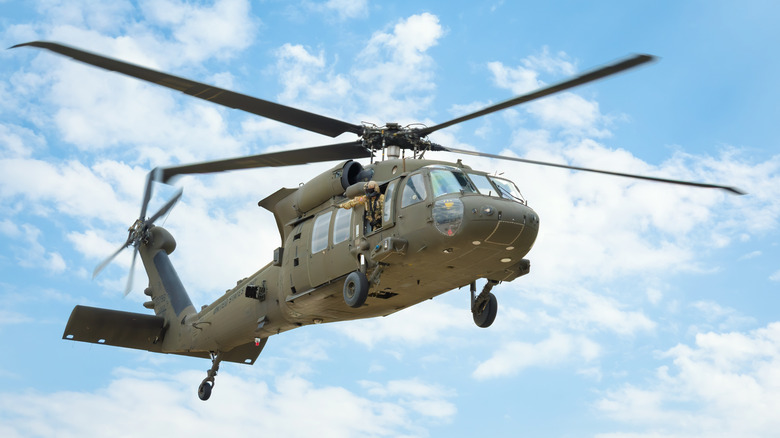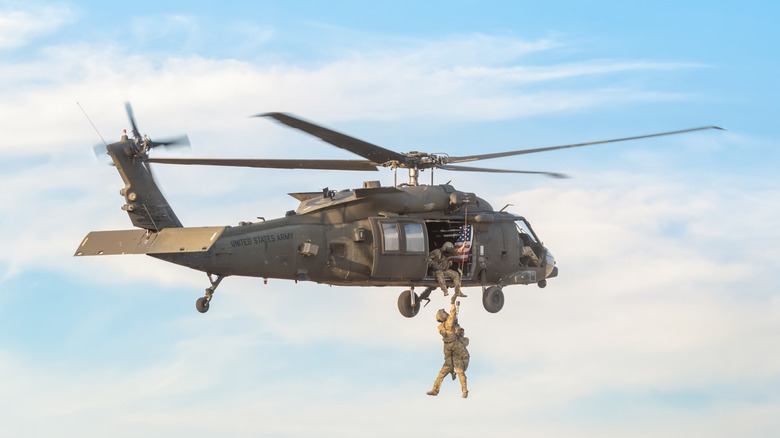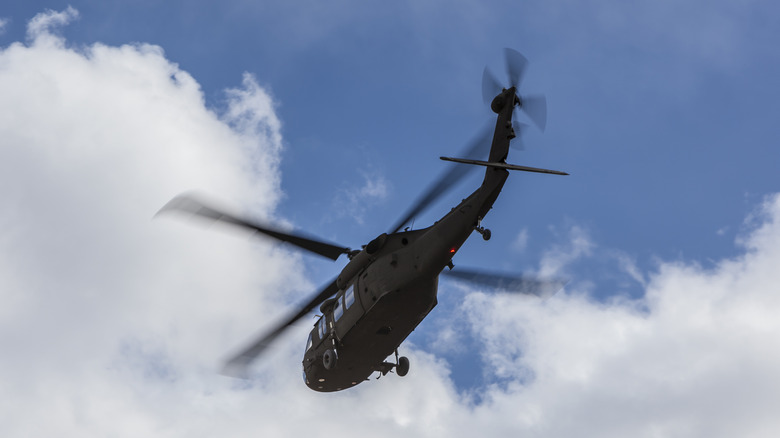Can A Black Hawk Helicopter Be Flown Remotely?
Thanks to new technology that allows aircraft to be flown from miles away, autonomous flying helicopters could be the future of the U.S. Army. In 2025, it was reported that the U.S. Army was partnering with aerospace company Skyryse to implement its SkyOS program, which would reduce pilot training time and allow the Army's 2,400 Black Hawks — and other aircraft — to be controlled without the need for a pilot at all. This is all focused on making the aircraft safer to operate, and more effective.
"By combining the Army's operational expertise with Skyryse's leadership in rotorcraft flight controls and automation, we have a unique opportunity to make flying simple and safe enough that any serviceperson can fly any aircraft," said Skyryse CEO Dr. Mark Groden.
It's been nearly a decade since the U.S. Army started testing out autonomous Black Hawks, with efforts ramping up more recently. In 2022, an autonomous Black Hawk demonstrated cargo resupply missions and rescue operations, led by Lockheed Martin's Sikorsky company and the Defense Advanced Research Projects Agency (DARPA). Then in late 2024, the Marines called on Sikorsky to showcase how it could autonomously fly the Black Hawk in battle.
The future of autonomous Black Hawks in the U.S. Army and beyond
Back in 2015, DARPA awarded $8 million to Sikorsky, the manufacturers of the Black Hawk, to start Phase 1 of the Aircrew Labor In-Cockpit Automation System (ALIAS) program, which would implement autonomous capabilities in existing aircraft. The initial tests were focused on a Black Hawk helicopter, utilizing Sikorsky's existing Matrix technology. By 2022, the first autonomous Black Hawk took off without a pilot, completing a 30-minute mission using ALIAS. It demonstrated how it would avoid buildings, carry out complex maneuvers, and land safely.
In 2024, the U.S. Army and Sikorsky showed military leaders what the Matrix system was capable of, with Mission Systems President Stephanie Hill inputting commands to a Black Hawk helicopter from 300 miles away. The Connecticut-based helicopter was controlled from the Association of the United States Army symposium in Washington, DC, using just a tablet. Despite the distance, the Black Hawk received real-time commands that it would then carry out autonomously.
In this 2024 test, a safety pilot was in the cockpit, but they didn't enter a single input as the aircraft took off, floated, and flew a set route. However, the Sikorsky Matrix system enables the Black Hawk to operate fully independently. It doesn't just follow a planned route — instead, the fully autonomous vehicle can react to combat and environmental threats, optimize its route, and even perform emergency procedures, all in real time. DARPA gave Sikorsky another $6 million in late 2024 to continue improving the Matrix system with AI technology into 2025.
Are Black Hawk helicopters dangerous to operate?
While the Black Hawk is a very commonly used specialized vehicle by the U.S. Army, it's the focus of various remote programs due to the dangers of flying it. The helicopter has been involved in numerous tragic accidents, even in recent years.
In 2023, there were three Black Hawk-related deadly crashes. In February, a UH-60 Black Hawk crash in Alabama killed two pilots during a training flight. While the aircraft was approaching the airport, it began to descend rapidly and eventually struck the ground. A month later, near Fort Campbell in Kentucky, two Black Hawks collided during a routine training mission, killing all nine soldiers who were onboard the helicopters. This was while they were forming a multi-ship formation using night-vision goggles. In November, five U.S. Army Special Operations aviation soldiers died during refueling training when the Black Hawk crashed into the Mediterranean Sea.
There have been 60 deaths related to Black Hawk training over the past 10 years. Despite the dangers, Black Hawk helicopters have been commonly used by the U.S. Army in Iraq, Afghanistan, Somalia, Ukraine, and other locations to support important missions. This even includes the assassination of Osama Bin Laden in 2011.


